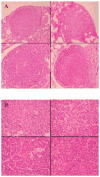Cancer-prone mice expressing the Ki-rasG12C gene show increased lung carcinogenesis after CT screening exposures
- PMID: 21962004
- PMCID: PMC3244170
- DOI: 10.1667/rr2649.1
Cancer-prone mice expressing the Ki-rasG12C gene show increased lung carcinogenesis after CT screening exposures
Abstract
A >20-fold increase in X-ray computed tomography (CT) use during the last 30 years has caused considerable concern because of the potential carcinogenic risk from these CT exposures. Estimating the carcinogenic risk from high-energy, single high-dose exposures obtained from atomic bomb survivors and extrapolating these data to multiple low-energy, low-dose CT exposures using the Linear No-Threshold (LNT) model may not give an accurate assessment of actual cancer risk. Recently, the National Lung Cancer Screening Trial (NLST) reported that annual CT scans of current and former heavy smokers reduced lung cancer mortality by 20%, highlighting the need to better define the carcinogenic risk associated with these annual CT screening exposures. In this study, we used the bitransgenic CCSP-rtTA/Ki-ras mouse model that conditionally expresses the human mutant Ki-ras(G12C) gene in a doxycycline-inducible and lung-specific manner to measure the carcinogenic risk of exposure to multiple whole-body CT doses that approximate the annual NLST screening protocol. Irradiated mice expressing the Ki-ras(G12C) gene in their lungs had a significant (P = 0.01) 43% increase in the number of tumors/mouse (24.1 ± 1.9) compared to unirradiated mice (16.8 ± 1.3). Irradiated females had significantly (P < 0.005) more excess tumors than irradiated males. No tumor size difference or dose response was observed over the total dose range of 80-160 mGy for either sex. Irradiated bitransgenic mice that did not express the Ki-ras(G12C) gene had a low tumor incidence (≤ 0.1/mouse) that was not affected by exposure to CT radiation. These results suggest that (i) estimating the carcinogenic risk of multiple CT exposures from high-dose carcinogenesis data using the LNT model may be inappropriate for current and former smokers and (ii) any increased carcinogenic risk after exposure to fractionated low-dose CT-radiation may be restricted to only those individuals expressing cancer susceptibility genes in their tissues at the time of exposure.
Figures






References
-
- Brenner DJ, Hall EJ. Computed tomography—an increasing source of radiation exposure. N Engl J Med. 2007;357:2277–84. - PubMed
-
- Einstein AJ, Henzlova MJ, Rajagopalan S. Estimating risk of cancer associated with radiation exposure from 64-slice computed tomography coronary angiography. JAMA. 2007;298:317–23. - PubMed
-
- Dauer LT, Brooks AL, Hoel DG, Morgan WF, Stram D, Tran P. Review and evaluation of updated research on the health effects associated with low-dose ionising radiation. Radiat Prot Dosimetry. 2010;140:103–36. - PubMed
-
- Mossman KL. Economic and policy considerations drive the LNT debate. Radiat Res. 2008;169:245–7. - PubMed

